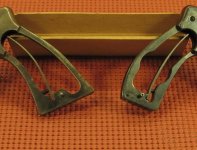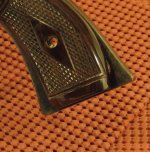Shep854 wrote:
Despite what the gentleman on the other forum said about the cost, I'd say you are getting full value on the transaction, if only for the fun you're having!
If you put a dollar value on all the work involved, it would surely exceed what you paid.
I think so too Shep. I try to tell people the same thing,...some of them listen, some don't. You learn how a thing works by taking it apart, fixing it, replacing a worn out part or two, and then you have something nice. Something you brought back from being broken.
I've had a gun in my hands as long as I can remember. I remember dad bringing me home a cap pistol when I was still young enough to be sleeping in my old wooden, cage bar side, baby crib. I actually remember that. Lots of cap guns in my boyhood. Most being pot metal, something would break. I'd take them apart and sometimes fix them and sometimes couldn't with my limited knowledge as a little boy. But I learned. My favorite set was my twin, blue handled, Hubley Colt 38's that I got for Christmas in 1960, seen below with me holding one in several pics from 1960. I was seven and Eisenhower was president.
An identical set of twin Hubley cap revolvers and holsters exactly like I had in 1960. Missed getting this one on e bay. Missed another just like it too. One day going to find that exact set again to hang on the wall with my pics from 1960.
We didn't have computer games back in those days and I spent my boyhood playing outside, climbing trees, cowboys and indians, Zorro, lone ranger, ect. I'd spend a lot of time in my dad's and granddad's workshops watching them fix things and I learned how to fix all kinds of things. Toasters, electric motors, just about anything. Built my own battery powered telegraph set. Made rubber band guns, crossbows, then much later graduated to BB guns. But if something broke, I could usually fix it.
The person at the other forum you spoke of Shep, doesn't understand. They don't see things through my eyes and do not realize how easily sometimes a thing can be fixed with just a little work and how satisfying it can be to do that. In this age of instant gratification, they are used to just buying something the way they want, then when it breaks, they get rid of it and buy something else. I still have tools that belonged to my grandfather who was born in 1898 and lived to be 98 yrs old. In my house before something gets thrown away, I see if I can fix it first.
I've been working on guns for about 40 years. Every gun I have owned I have taken apart to see how it works. Fixed lot of friends and family's guns. Made my own parts many times. Stoned trigger sears, cut black powder barrels and rammers then put sights back on them and re-cut the rammers and latches. Brought an Austrian Steyr hahn 1912 pistol back to life with some filing and a new extractor. Slicked up the actions on my nickel 1860 fluted cylinders Pietta Colt clones.
Turned my 1911 into a long barreled carbine. Spliced broken stocks back together under the barrel band so the splice couldn't be seen, using walnut I carved to shape myself for the upper fore end on an '03 Springfield. Spied by eye a 1896 Krag rifle receiver in a box of rusted metal scrap my cousin had. Cleaned it up for him to use as a good receiver for a restoration. Also broke free his Spencer repeating rifle so it will work again. Multiple little things you pick up along the way from reading about and working on guns.
Made holsters and repaired holsters. Just innumerable things I learned to do with guns. Mostly by hand with a minimum of tools. Like the Arabs do in the Kyber Pass. Although I've accumulated a few tools along the way too. I like aviation and scuba, but guns have been my life long hobby.
It's kind of like art. Someone else may look at an old beat up rusted gun and just see that. I see what I can make it become, and realize with past experience that I can make it become something again. Working on guns builds self confidence so that when a person gets enough experience doing it, they aren't afraid to tackle just about any gun project. But they have to want to do it, enjoy doing it, get a great deal of satisfaction doing it, and maybe listen to an old guy or two along the way when he tells them it isn't a "Piece of scrap metal junk that they think he got took on" when he tells them it isn't. Lol.
But sometimes, rather than just tell them, you have to show them and prove it. Then they and others might get interested enough after watching, to try a few gun project fixes theirselves. Half the time it amounts to just a good clean up and maybe replacing a part or two. Other times it takes a bit more. But all of it is doable and quite often just using simple hand tools like files and elbow grease. Other times you need special tools. I'm not a professional gunsmith, but I'm a self taught amateur one. I don't have the knowlege nor tools of a professional gunsmith. I just fix and do what I can, and if I get stumped, I find someone who can fix it.
All I know is I like it and as you observed, I'm having a lot of fun bringing this old S&W 1917 Snubby back to operational life. Another thing I've done and still do, did it with the snubby and will continue to do so until it is completely finished....is after first using steel wool on it, to get it pretty smooth, I get a little nose and forehead oil on my fingers and I rub the revolver parts hard with my fingers. Might be sitting watching a movie and just rubbing parts of the revolver. You'd be surprised how much rust and dirt you can get off a gun just by rubbing it with your fingers. Makes your fingers strong too. No substitute for buffing but can get it ready for buffing. After using steel wool on it and rubbing the parts with my fingers and fingernails, there is no rust left on the revolver at all except in the bottom of a few tiny pits. This is before it even gets to the buffing wheel. If you've ever noticed a worn doorknob or handrail worn smooth with no rust, same thing. From hand rubbing.
By rubbing like I describe, you will also feel every little nick and burr and rust spot by doing that and know by feel, without even looking, where those spots are to fix with sandpaper, or a jeweler's file (AKA mini files) and buffer. (Most important to have jeweler's/mini files). You will feel the raised area around a stamp, a nick on the edge of a cylinder flute, a rust spot or pitting, etc. And you will remember they are there because you rubbed it so much that you know exactly where every little imperfection is to fix. I also like to think all that rubbing and pressure I put on the gun with my fingers, infuses a little bit of me and my spirit into it. One quality it takes is a lot of patience.
Things like that are difficult to teach to consumer/computer age youngsters who didn't grow up fixing all kinds of things. You can try, but ultimately they have to want to learn, seek out gun repair books and manuals, gain experience and teach themselves like I did. For them to do all that, they have to be driven by a passion for guns. That's not really something you can teach, but you can encourage.
So when someone like that tells me I got took on a "Piece of junk scrap metal", I just smile and resolve to show them what it will become after I get finished with it.
.





















